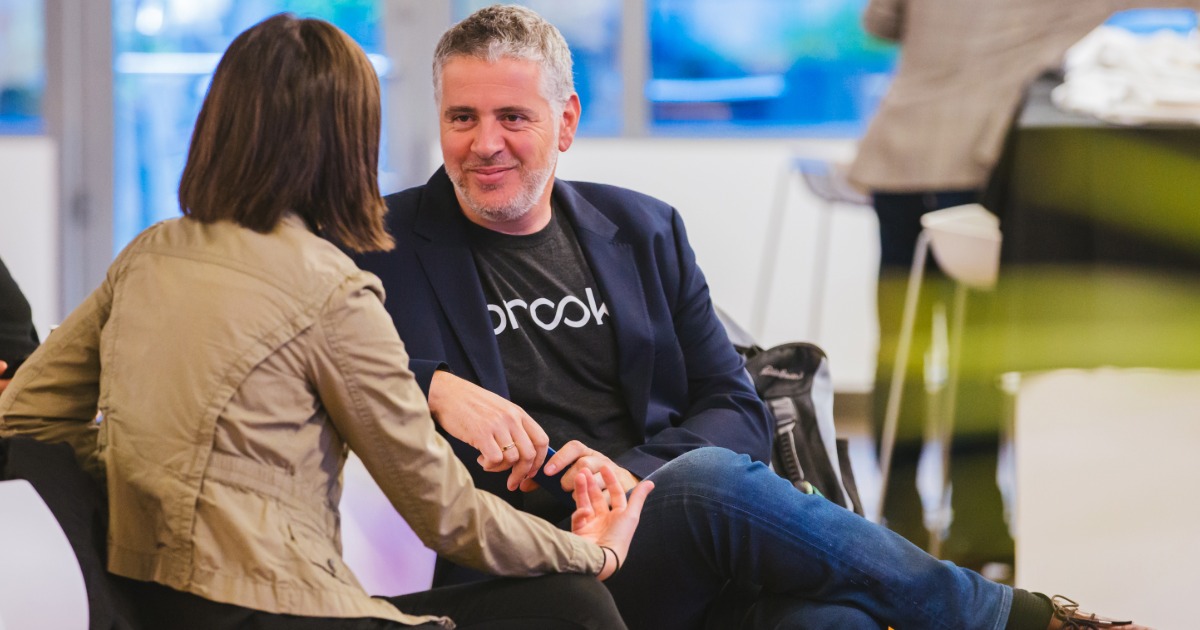
Countless clinicians are burned out. Many won't even recommend their profession because of the amount of administrative burden they face.
But in recent years, the rise of artificial intelligence has brought about the ability to automate and streamline much of this work.
So, on the one hand, you have a group of very sophisticated professionals who are exhausted and really want to use some technology other than the one they're using now. And on the other, you have vendors of a newer technology who are looking for groups of users.
Not to mention hospitals and health systems – significantly low-margin businesses with huge capital expenditures – unable to keep up with the workload that's required.
What you get is a perfect storm for a technology that is exploding in healthcare today – AI-powered ambient assistants and scribes. AI ambient scribes focus, more or less, on the ability to listen to conversations between doctors and patients, automatically transcribe them with great accuracy, and insert them into an electronic health record.
AI ambient assistants do everything a scribe does but much more, helping physicians with all sorts of clinical and administrative tasks.
Punit Soni is CEO and cofounder of Suki, an eight-year-old, San Francisco-based artificial intelligence ambient listening assistant vendor. Healthcare IT News sat down with him to discuss what AI assistants can do, the market for these blossoming assistants and scribes, his company and the future of the technology.
Q. First of all, how do these systems work?
A. The first question your readers should ask is, "What is the actual system? What does it even do?" Because there is so much noise in the market, and very few players are building something that can create significant value, end to end.
Suki builds an AI assistant for doctors. It is not a scribe – they just write notes for you. Ours is an actual assistant.
What would a human assistant do for a clinician if they were at their shoulder walking with them? They could tell the doctor what his schedule looks like. They could give him summaries. For example, if the doctor is going to see Bill, the doctor could say, "Tell me what I need to know about Bill before I walk into the room."
The assistant then would summarize Bill's history and prior visits. They could tell the doctor, "Here are some of the care gaps you should know about. Here are the prior problems of Bill that you should know about when you walk in."
An AI assistant does these things. And when the doctor walks in, he can say, "Suki, pay attention." And Suki listens to the doctor and Bill talking and creates a clinically accurate note that represents that encounter in the form of problem-based charting.
If Bill has two or three issues he and the doctor discussed, the AI assistant documents each of them separately. It extracts the diagnosis for each one of them. It attaches ICD-10 and CPT codes for anything that doctor diagnosed or referred as a procedure so the doctor ultimately will get paid because of it.
It can stage the orders. If the doctor said, "Prescribe X milligrams of Doxycylin over the next five weeks for Bill," it can stage that directly into the electronic health record system. And finally, it should take all that information it created and write it into the EHR as if the doctor went in and personally typed it in.
That's what an assistant does. That's what Suki does. It's an assistant that can do all of these activities so the doctor only does one thing, which is look at Bill in the eye, ask him how he's feeling, and make sure he can focus on what matters most, which is patient care.
Q. Where throughout the enterprise of a hospital, health system or group practice are they being used, and what hard benefits do they bring to these areas?
A. Suki conducted the Phyx Primary Care Study, which is really fascinating. This study worked with 115 physicians across 37 practice locations, conducted surveys and came up with these numbers. Use of the AI assistant: decreased time per clinical note by 41%; decreased documentation burden for the physician by 27%; decreased the number of visits where somebody felt rushed by 32%; increased the number of notes done before the next patient comes by 46%; and increased the number of notes finished in the same day by 33%.
These are really great numbers, but there's a higher order number that trumps all of this. This is all true only if the AI assistant is actually used.
If the doctor adopts it and uses it, all of these great numbers will actually show up. The Phyx study does a really good job of expressing what happens when an AI assistant has been adopted by a lot of different doctors in different clinics. But what is the adoption rate of these technologies?
We meet the doctor exactly where he is. It's not an iOS app, Android app, web app, Windows app or dictation app. It's within the Epic EHR. It's integrated.
And it's deeply integrated into the EHR. It's not just take a note and paste it somewhere. Orders go into the right places. Problems go into the right places. Notes go into the right places. Coding goes into the right places. Everything is done so the doctor doesn't have to touch the EHR. That is when you actually have full integration.
And then finally, it does a lot more than scribing. It's an assistant, which means doctors have a lot more reason to use the product, not just note-taking.
Q. What are some challenges hospitals, health systems and group practices must face with genAI? Where must caution still be applied since AI, of course, is not perfect and can indeed hallucinate?
A. There are a few places where challenges must be thought about. The highest-order challenge is in the quality of the AI output. This is a place where I will caution those who work in health systems to be careful to select products that are enterprise-grade in scale and not just wrapping large language models and using them.
The No. 1 challenge or caution I have for people assessing these things is when you are looking at an ambient system, ask the company you're talking to, "What's your quality metric? What's the rubric you use? What's the quality ecosystem? Can you tell us you have a high-quality product?" That's No. 1. And that's not an easy one. And it's a high-liability, high-competence area.
No. 2, the scale and infrastructure required to do this. Thousands and thousands of doctors using it live across all these specialties with the right privacy, the right data security, the right compliance [requiring] an infrastructure that is bigger than entire companies.
So, the No. 2 thing I would say in terms of caution is, please make sure you spend time understanding the infrastructure of compliance, privacy and data that's available in these systems you look at.
The final comment I'll make is, EHR integration is a much-maligned term. Everybody shows up and says "Oh, we are integrated in the health record system." The best they might actually do is just integrate some schedule and show some patient names. That is not EHR integration.
EHR integration is when you can pull data from the EHR live, use it to understand the context of the patient you're serving, and then be able to write things and output things with that context and push it back into the right place in the EHR.
That requires deep product and commercial relationships with the underlying EHRs and working closely with them, hand in hand, as joint partners. Therefore, anybody who's making the pitch, my caution to you is find out and ask them, "Is the underlying EHR a close partner? What integrations are we talking about?"
At the end of the day, quality of AI output, compliance, security, privacy, infrastructure and the depth of EHR integration – go deep into these things before you make a choice on what's the right ambient service for you because this typically is where the challenges are.
Q. Suki is gaining a lot of traction in the industry. To what do you attribute your success to date?
A. Whatever success we have had so far I would attribute to not thinking of this as a business. There is a higher-order mission to this that has to be incorporated into what you do. Yes, business matters, but the higher-order mission and vision also matters. Otherwise, you will find it really hard to live through the painful uphill battle of building something here.
At the point when you don't have enough money and your business is struggling, what keeps you going is passion and vision for what you want to do for the world using your technology. We have a powerful vision and mission behind us. That's No. 1.
No. 2, we care deeply about who we serve. We serve the clinicians, and we want to make sure their lives are better. If you have that understanding in your strategy where everything you do is in the service of that clinician, you end up building products people love and care for. If that happens, then the money will follow, business will happen.
Finally, No. 3, there needs to be an orientation of humility. Humility in how you sell, humility in how you build, humility in what value you create for people. When you put up a slide that says, "I have created ROI for you," it needs to be backed up with actual hard numbers jointly produced between you and the health system you're working with.
Q. What does the future look like for hospitals, health systems and group practices applying AI-powered ambient technologies? What does the evolution look like in your eyes?
A. The sky is the limit. It's just going to be so amazing. The world around us, not just healthcare, every aspect of the world around us is going to fundamentally change. There are, in my opinion, three epochs of humankind. The printing press was an epoch. The Internet is an epoch. And AI is going to be another epoch.
There is going to be a new user interaction model. AI is the new UI around us in terms of how people are going to be experiencing interactions with each other and interactions with technology. In a human-centric world, a place like healthcare is going to be even more obvious.
I expect every single aspect of healthcare that involves lots of nonhealthcare-oriented tasks like documentation, coding, revenue cycle management, figuring out how to reach people in the steps that have to be taken, patient engagement – I expect all of them to be completely automated and completely invisible from a technology perspective.
They will all be done automatically using what we call ambient clinical intelligence.
So, the world I'm looking at, if we are lucky, there will be pockets of healthcare in the next five years where all technology will become assistive and invisible, and all clinicians will be able to do exactly what they love and care to do, which is patient care.
This is not too far off. And if it happens, and if we're lucky and all of this plays out, it will lead to tremendous decline in the cost of healthcare infrastructure. It will lead to a tremendous increase in access to healthcare to people who didn't have access to healthcare.
Think about rural America. Think about pockets where there are healthcare deserts. And it will lead to a resurgence of healthcare workers who will want to come in because they are focused on humans, not on the technology of running healthcare. So, I'm optimistic. I think in five years, we'll probably see some of this play out.
Click here to watch a brief video of bonus content, where Punit Soni of Suki offers advice to healthcare CAIOs, CIOs, CTOs and others implementing the systems and to doctors and nurses using the technology.
Follow Bill's health IT coverage on LinkedIn: Bill Siwicki
Email him: bsiwicki@himss.org
Healthcare IT News is a HIMSS Media publication.
WATCH NOW: How to launch a healthcare AI project, per the VA AI chief


